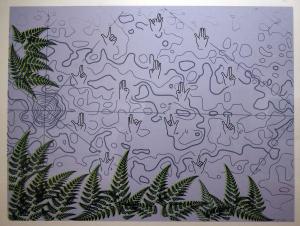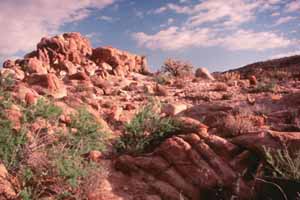The week that was, 8/3-9/2009
Posted on | August 9, 2009 | No Comments

"Reflections, 2007." Click on the image for a profile of the artist, Anna Bliss, in the Salt Lake Tribune
New TV ads are encouraging Brazilians to save water — by peeing in the shower. — AP / Salt Lake Tribune and New York Times
One homeowner, for instance, insisted his three-day-a-week watering schedule was insufficient to create the large bill … He left out that he waters four times on each of those three days. — Denver Post
As the state entered a severe drought, many of the city of Sacramento’s biggest water users increased their watering dramatically … A Bee investigation reveals city government itself as the top scofflaw. — Sacramento Bee via Aquafornia
Think of our water supply as a giant milkshake glass. And imagine each demand for water as a straw in the glass. Most American states allow a limitless number of straws in the single glass. — Robert Glennon, author of Unquenchable, in the Arizona Republic
“The crisis is in Atlanta,” said Paul DeLoach of Flint Riverkeeper, a local conservation group, suggesting the rural region shouldn’t be concerned about the ruling [cutting off Atlanta from Lake Lanier]. “No, the crisis is in Georgia,” said Governor Sonny Perdue — AP / Denver Post
“Most of us regard babies as blessings, but with their first breath of oxygen, they are consumers and, just like the rest of us, with every succeeding exhalation, they are contaminators.” — Elise Lazar, co-chair of the Salt Lake Mayors’ Green Team in the Salt Lake Tribune op-ed “Overpopulation: The elephant in the room”
The Eugene Water & Electric Board plans to shorten the official name of a Leaburg park because the current one includes a torture technique. The board’s switching the name from Lloyd Knox Water Board Park to simply Lloyd Knox Park — AP / Portland Oregonian
“More than 80 inches of rain swamped Taiwan…” — the New York Times on Typhoon Morakot as it moved from Taiwan to mainland China
The floating mass of trash, located north of the Hawaiian Islands, is estimated to be twice the size of Texas and is made up of at least two smaller patches, the largest of which is estimated to contain at least 3.5 million pounds of trash, according to www.greatgarbagepatch.org — Aquafornia spotting an Accu-Weather item
“… if it’s an act of God, I need to know so that I can check in with him” — Utah Lieutenant Governor Gary Herbert on the need for an investigation into the Logan canal disaster, Salt Lake Tribune
“The past just can’t happen again.” — Jeff Cundick, the Bureau of Land Management minerals chief in Pocatello, Idaho on a new application from Monsanto to mine for phosphate for its best-selling herbicide Roundup. Three of the St. Louis-based chemical company’s previous Idaho mines are under federal Superfund authority, a fourth is now violating federal clean water laws, AP / Denver Post
“Assume it can happen.” — Lori Schmidt, spokeswoman for the Scottsdale, AZ fire department, on the probability of drowning, Arizona Republic
“In this case, a pile of rocks is more than just a pile of rocks.” — New Mexico Mining and Minerals Division Director Bill Brancard asked about 259 abandoned uranium mines in New Mexico, AP / Salt Lake Tribune
 “I think this is just a rich guy who just wants to move water.” — Wyomong Governor Dave Freudenthal on Aaron Million’s proposed 560-mile-long pipeline that could carry up to 250,000 acre feet of water a year from the Green River, in the Flaming Gorge Reservoir area, to Colorado’s Front Range and beyond, AP / Salt Lake Tribune
“I think this is just a rich guy who just wants to move water.” — Wyomong Governor Dave Freudenthal on Aaron Million’s proposed 560-mile-long pipeline that could carry up to 250,000 acre feet of water a year from the Green River, in the Flaming Gorge Reservoir area, to Colorado’s Front Range and beyond, AP / Salt Lake Tribune
“Read them. Think about them. Talk about them. [Assembly Bill No. 1 – AB 39 (Huffman), Assembly Bill No. 2 – AB 49 (Feuer), Senate Bill No. 1 – SB 12 (Simitian), Senate Bill No. 2 – SB 229 (Pavley), Senate Bill No. 3 – SB 458 (Wolk), Summary of Delta/Water Legislation] But hold your fire … There is a lot in these bills: creation of a new, potentially powerful water institution (a Delta Stewardship Council); an effort to strengthen an existing water institution (the State Water Resources Control Board); a requirement that water conservation be pursued more aggressively in both the urban and agricultural areas; a call for evaluating new infrastructure (including, yes, some kind of Peripheral Canal); creation of a Science Board; establishment of a standardized water use data collection and reporting system; establishment of a user fee for Delta water users; a call for monitoring of groundwater levels. ..doing nothing is not an option, unless whatever we do makes things worse. And posturing right now will make things worse.” — Peter Gleick, President of the Pacific Institute in the San Francisco Chronicle on five water bills in the state legislature
” … whistling past the graveyard is both unrealistic and unwise.” — Rep Earl Blumenauer, D-Ore, on a new bill requiring the US Corps of Engineers to study the removal of dams on the Snake River, Portland Oregonian
 “It has reversed the flow of the sewer line.” — William Lund, senior scientist with the Utah Geological Survey for southern Utah on the effect of a two-and-a-half mile-long fissure in Southern Utah caused by over-pumping of the aquifer, Salt Lake Tribune
“It has reversed the flow of the sewer line.” — William Lund, senior scientist with the Utah Geological Survey for southern Utah on the effect of a two-and-a-half mile-long fissure in Southern Utah caused by over-pumping of the aquifer, Salt Lake Tribune
The steady drain on underground reserves grows out of two realities: Canals and pipelines don’t reach far enough to deliver surface water to everyone, and laws don’t reach far enough to stop people from drilling. — Shaun McKinnon, Arizona Republic
“It is high risk to assume that the worst is not going to happen … You’re going to live like Amman, Jordan. You’re going to get water once a week.” — Southern Nevada Water Authority General Manager Patricia Mulroy in the Las Vegas Review-Journal on why she believes that Las Vegas must pump the aquifer lying between Utah and Nevada
 “…National park units can serve as the proverbial canary in the coal mine, a place where we can monitor and document ecosystem change without many of the stressors that are found on other public lands.” — Jonathan Jarvis, Barack Obama’s nominee for the National Park Service director, quoted in the Los Angeles Times.
“…National park units can serve as the proverbial canary in the coal mine, a place where we can monitor and document ecosystem change without many of the stressors that are found on other public lands.” — Jonathan Jarvis, Barack Obama’s nominee for the National Park Service director, quoted in the Los Angeles Times.
“The aquifer system is naturally recharged by precipitation (rainfall and snow melt) that occurs within a regional watershed of 1,300 square miles. For this reason, any water that is transferred to Southern California will be naturally replenished over time.” — Cadiz, Inc current claim pushing a massive Southern California groundwater pumping project near the Mojave National Preserve, quoted in “Question time for Cadiz,” Chance of Rain
What in fact independent review showed of the Cadiz proposal “… the Cadiz Groundwater Resources report was critically and objectively reviewed by the US Department of Interior Geological Survey, National Park Service hydrologists and water rights specialists with our Washington office, and experts with the County of San Bernardino. Each of these groups has independently drawn the conclusion that the groundwater study conducted in support of the Cadiz Environment Impact Statement is seriously flawed.” — Cadiz Groundwater Storage and Dry-Year Supply Program Final Environmental Report/Final Environmental Impact Statement, Volume II, Section F2, Page 2
As of Thursday, the U.S. National Snow and Ice Data Center reported, the polar ice cap extended over 2.61 million square miles (6.75 million square kilometers) after having shrunk an average 41,000 square miles (106,000 square kilometers) a day in July — equivalent to one Indiana or three Belgiums daily –– AP / Denver Post
“At the end of summer, especially this summer, glaciers are the only show in town for fresh water.” — Edward Josberger of the USGS Water Science Center in Tacoma, Wash., on the shrinking snowmelt source for Pacific Northwest streams, Portland Oregonian
Villaraigosa was in Iceland last week with his son and a few friends. A knowledgeable source, who spoke on condition of anonymity to protect his relationship with officials, said the mayor’s retinue included Richard Katz, his point-man at the Metropolitan Transportation Authority, and Keith Brackpool, chief executive of the company known as Cadiz. Brackpool’s company, which hopes to complete a water banking project in the Mojave Desert, has employed both Katz and Villaraigosa over the last decade. — Los Angeles Times
The water isn’t filtered or mixed with anything but chlorine, ammonia and sodium hydroxide. — Portland Oregonian on the local fight against an EPA mandated filtering plant.
August 10: This post has been updated. The item about the Pacific garbage patch has been added.
Comments
Leave a Reply




